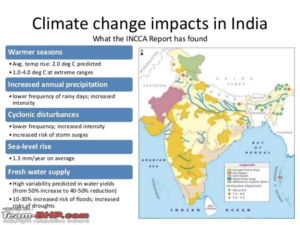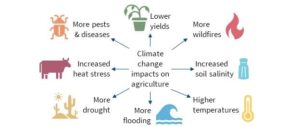Agro Climate Crisis.
Relevance:
- GS Paper-1 Climate and India.
- GS Paper-3 Various crops and cropping patterns.
- Tags: #upsc #climate #cropping patterns #driestaugust #IMD #rainfall.
Why in the news?
- The prediction of IMD depicts normal rainfall for September, but the government’s aggressive ban on rice exports and other custom duties on vegetables and other food products clearly point to another reality- food crisis.
- Delhi, and India, are experiencing a drought-like August. The figures speak for themselves as India reported its driest and hottest August since 1901.
- Reports also suggest this may be the second-driest August Delhi has ever seen (the driest was in 2022).
Issues in India
- As per a global report on climate change, India “was the seventh most-affected by the devastating impact of climate change globally in 2019,” with changing climate eating as much as 0.72% of the country’s GDP.
- India is currently in the El Niño year and is expecting disruption in monsoons which may lead to droughts and food security problems.
- The predictions seem to be coming true as August reported 36% below normal rainfall.
- The southern peninsula reported 60% below average rainfall, alarming rain-fed farmers in these areas.
- These fears have also started to ring in the government’s ears, as there was a 20% increase in demand for work under the MGNREGA due to the vagaries of the weather.
- Farmers already gauging the situation have decreased paddy acreage by 384 hectares, a 4% drop from the previous five-year average.
- Farmers in India’s food bowl Punjab, Haryana and Uttar Pradesh in the north are also suffering the brunt of untimely rainfall.
- Other crops like legumes, oilseeds and paddy are affected by changing weather patterns. In retrospect, Cyclone Biparjoy heralded the monsoon deficit for the subcontinent.
- The people with irrigation options or “underground boring” will be heavily dependent on the ever-shrinking surface and ground water resources.
- The Rabi harvests have been below average for the past two years now. Kharif over the last couple of years hasn’t been the best either.
- Untimely rainfall, heatwaves and hailstorms have done the most damage across the subcontinent.
Phases of Agro- Climate Crisis
The First Phase Of The Agro-Climate Crisis
- By 2022, we see the pattern re-emerging with dampened Rabi harvests, untimely kharif rains and kharif paddy production dropping by 6%. Meanwhile, heat-related deaths increased by 55% in 17 years. Prolonged climate agrarian disruptions – became visible in 2019, with disrupted monsoons, floods and eight tropical cyclones.
- Overall, about 40% of the 703 districts in India had average rainfall. In six years (2015-21), India lost 33.9 million hectares of cropland to floods and excess rains and 35 million hectares to drought – numbers which are likely to increase as years progress.
- The victims were not just humans, but also the Rabi wheat crop in north India, which reportedly shrank by at least 13.5%. The government was quick to ban wheat exports, while trying to curtail public panic.
- The unusual locusts attack in 2020 damaged crops all across the western and northern subcontinent. The untimely rainfall provided new breeding grounds for locusts in western India.
- Even a Punjab Agriculture University study concurs with the finance minister’s view and predicts that Punjab by 2050 will be grappling with changing climate and experience significant yield loss due to rising temperatures.
- And then came Biparjoy, tearing into the western subcontinent and drying up our monsoons.
The Second Phase of the Agro-Climatic Crisis
- Economic phase of the Agro-climatic crisis is reached – hyper food inflation.
- From tomatoes and onions, now the inflation is reaching other staples like legumes and vegetables.
- Fodder prices are increasing gradually, as the Indian system is losing its resilience because of climate disruptions.
Effects of Climate Change
Changing weather patterns are creating significant challenges for farmers across the country. Some of them are given below-
Loss of crop Production
- Crop production is projected to decrease in many areas during the 21st century because of climatic changes.
- Higher temperatures tend to reduce crop yields and favor weed and pest proliferation.
- Climate change can have negative effects on irrigated crop yields across agroecological regions both due to temperature rise and changes in water availability.
Price Inflation
- Climate change is altering weather patterns, directly impacting 55 percent of the country’s inflation basket.
- For example, a heatwave in March played havoc with the wheat crop.
- Despite a ban on exports, wheat prices have risen 19 percent.
Steps taken by the government so far
- National Mission for Sustainable Agriculture (NMSA) to make agriculture productive, sustainable and remunerative and climate resilient.
- It also developed capacity of farmers and stakeholders in the domain of climate-change adaptation and mitigation measures.
- Soil health card scheme in 2015 which will carry crop-wise recommendations of nutrients and fertilizers required for the individual farms to help farmers to improve productivity through judicious use of inputs.
- Climate Change Knowledge Network in Indian Agriculture to establish ICT-enabled approaches for knowledge exchange on climate-change adaptation in Indian agriculture.
- The eArik project was initiated in North East to disseminate climate-smart agricultural practices.
- Pradhan Mantri Fasal Bima Yojana is in the direction of government saving farmers from the wrath of frequently changing climate patterns.
Apart from all this, government of India started National Innovations in Climate Resilient Agriculture (NICRA) to make the farmers self reliant by use of climate resilient agricultural technologies.
Key aspects of NICRA are
- Critical assessment of different crops/zones in the country for vulnerability to climate.
- Installation of the state-of-the-art equipment for measurement and impact understanding of GHGs on agriculture.
- Strategic research, technology demonstrations and capacity building are the objectives.
- Enhance the resilience of Indian agriculture to climatic variability and climate change.
- Development and application of improved production and risk management technologies.
- Area-specific technology packages on farmers’ fields for adapting to current climate risks.
- Enhance the capacity of scientists and other stakeholders in climate-resilient agricultural research.
Way Forward
Measures
- Expand PM Kisan Insurance Scheme to include climate damage.
- Insurance companies should compensate for crop value.
- Steadfast mechanism to report directly to insurance companies.
- Third-party audit to verify farmer’s claims.
- Long-Term Measures:
- Abandon the green revolution paradigm
- It will ensure climate adaptation and nutrition security.
- Research and Development on climate resilient agriculture.
- More funds need to be allocated for R&D purposes.
- Increase Private sector participation.
- Indian companies should be invited to expedite R&D on climate resilience.
- Govt must encourage private sector participation in seed division.
- Development and identification of climate-resilient seeds.
- It should be used for vulnerable areas and emergency situations.
- Encourage multi-culture and inter-cropping.
- Monoculture practices should be discouraged.
- Promotion of Organic farming.
- More funds should be given to improve organic farming and organic produce market.
- It will cut down the bills of subsidy and ensure nutrition security.
- Natural methods to mitigate climate change should be promoted.
- Govt should incentive the growing of agro-climatic zone-specific crops.
- Development of Patent-free climate seeds & technologies.
Source: The Wire
Mains Question
How climate change has impacted the agriculture and discuss the ways to do smart agriculture.





